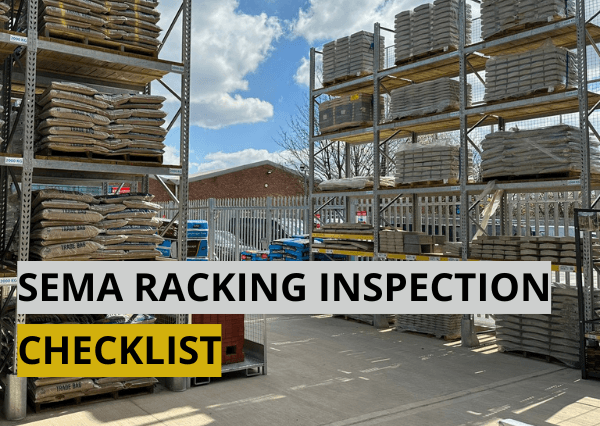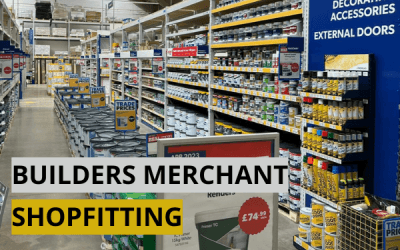Having an SEMA racking inspection checklist will help you ensure the safety and efficiency of your warehouse operations and the integrity of your racking systems.
Regular inspections are not just a matter of best practice—they’re essential for preventing accidents, maintaining compliance with safety standards, and keeping operations running smoothly. A SEMA (Storage Equipment Manufacturers’ Association) racking inspection checklist is your ultimate tool for achieving these goals.
Table of Contents
Why Are Racking Inspections Important?
Racking systems are the backbone of any warehouse, but they face daily stress from heavy loads, forklift impacts, and general wear and tear. Over time, even minor damage can compromise the structural integrity of your racking, creating dangerous conditions for your team and assets.
According to the Health and Safety Executive (HSE), inadequate maintenance and failure to identify damage are common causes of workplace injuries in warehouse environments. Regular inspections ensure that potential risks are identified early, reducing the likelihood of costly repairs, operational downtime, and serious incidents.
A proactive approach also helps businesses stay compliant with legal requirements such as PUWER (Provision and Use of Work Equipment Regulations), which mandates that all equipment must be safe to use and properly maintained.
The SEMA Racking Inspection Process
SEMA recommends a three-tiered approach to racking inspections. This comprehensive system ensures that all levels of risk are addressed, from daily wear to more significant structural concerns.
1. Immediate Reporting by Staff
All staff members are encouraged to report any visible damage or safety concerns as they occur. Whether it’s a dented upright or a loose bolt, immediate reporting allows for quick action and minimizes the risk of further damage.
2. Regular Visual Inspections
Designated as the responsibility of the Person Responsible for Racking Safety (PRRS), these weekly or monthly checks focus on identifying visible signs of wear and tear. This includes inspecting beams, uprights, and floor fixings for damage.
3. Annual Expert Inspections
A SEMA Approved Racking Inspector (SARI) should conduct a thorough annual inspection. These professionals are trained to identify less obvious structural weaknesses and provide detailed reports, complete with recommended corrective actions.
What Does the SEMA Racking Inspection Checklist Include?
A SEMA racking inspection checklist is designed to systematically assess every aspect of your racking system.
Here are the critical components:
1. Upright Frames
- Check for dents, twists, or other deformations that could compromise load-bearing capacity.
- Inspect for rust or corrosion, particularly at the base of the uprights.
2. Beams
- Look for cracks, deflections, or signs of overloading.
- Ensure beams are correctly seated and that beam connectors are securely in place.
3. Connections and Clips
- Verify that all bolts, safety pins, and locking clips are present and undamaged.
- Replace any missing or faulty components immediately.
4. Load Signs
- Ensure load capacity signs are installed, visible, and legible.
- Update signs if there have been changes to your racking configuration or load limits.
5. Floor Fixings
- Examine base plates and floor anchors to confirm they are secure and undamaged.
- Check for cracks or wear in the surrounding concrete.
6. Rack Protection
- Assess the condition of column guards, end barriers, and corner protectors.
- Repair or replace any damaged protective measures to safeguard against further impacts.

The Traffic Light System for Damage Assessment
SEMA uses a simple traffic light system to categorize damage, making it easier for inspectors and managers to prioritize actions:
- Green: No action required; the racking component is in good condition.
- Amber: Damage is present but not critical. Monitor the issue and schedule repairs as soon as possible.
- Red: Severe damage detected. The affected area must be unloaded immediately, and repairs should be carried out before the racking is used again.

Best Practices for Implementing the Checklist
An effective inspection routine requires more than just a checklist—it demands a commitment to safety culture. Here’s how to make the most of your SEMA racking inspection checklist:
1. Train Your Team
Ensure your PRRS and warehouse staff are properly trained in racking safety and the inspection process. This not only enhances the quality of inspections but also empowers your team to identify and report potential hazards proactively.
2. Keep Detailed Records
Maintain a log of all inspections, including dates, findings, and actions taken. These records can be invaluable for tracking recurring issues, planning maintenance, and demonstrating compliance during audits.
3. Act Promptly on Findings
Don’t delay addressing issues flagged during inspections. Even amber-rated damage can worsen over time, increasing the risk of accidents and costly repairs. Establish a clear process for escalating and resolving identified problems.
4. Partner with Experts
Annual inspections by a SARI-certified professional are non-negotiable for ensuring comprehensive assessments. These experts have the knowledge and tools to spot issues that might be missed during regular visual inspections.
Common Racking Issues to Watch For
While a checklist is comprehensive, certain issues tend to crop up more frequently in warehouses:
- Overloading: Ensure that racking systems are not exceeding their specified load limits.
- Forklift Damage: Impacts from forklifts can dent uprights and dislodge beams.
- Poorly Distributed Loads: Uneven loading can create imbalances, increasing the risk of collapse.
- Environmental Damage: Moisture, temperature fluctuations, and chemicals can accelerate wear and tear.


Conclusion
A SEMA racking inspection checklist is an invaluable tool for maintaining a safe and efficient warehouse environment. By incorporating regular inspections into your operations, you can proactively manage risks, ensure compliance, and safeguard your team and assets.
At Ashford Retail Services, we specialise in racking inspections and maintenance, helping businesses across the UK achieve peace of mind. Contact us today to schedule your next inspection or learn more about our services.




